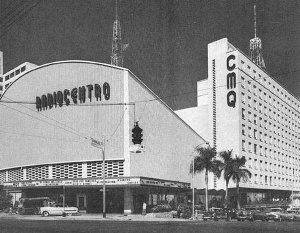The members of the staff in charge of the organizational project were: Ramiro Quiroga, Aurelio Martínez, Humberto Pérez, Julio Alom Alom, Pitín (comic book artist from Palante), Lázaro Bravo and Renaldo Infante Urivazzo. Ramiro Huerta, who at that time directed the Broadcasting Office, became in the first director of the Institute, some years later Aurelio Martínez hold this charge. At the beginnings Lázaro Bravo hold administrative functions. Other people linked to the creation of the institute were Doctor, Gregorio Ortega CMQ’s auditor and later Television director and José Caiñas Sierra as Radio director.
Marcos Behmaras who has been in charge of Radio Progreso after its intervention on July 2nd, 1960 along with Orlando Fundora to the Radio Internacional, with Radio Habana Cuba in 1961. According to Renaldo Infante, engineer Carlos Estrada Castro was in charge of the technical direction. CMQ radio direction was to Amaury Pérez Garcia meanwhile José Rodríguez Méndez was the director of Television news after the unification of the Revolutionary radio news of Channel 2 and the ancient CMQ TV news on November 2nd, 1961. Manolo Ortega and Eddy Martin were the radio announcers that inaugurated the radio station.
Other responsibilities for the radio station fall in shoulders of Antonio Hernández(Ñico), as Chief of Remote Control; Ibrahim Urbino and Joaquin G Santana, International Affairs; Mirta Muñiz Egea, Spreading and Public Relations; José Varela(El Gallego) and René Ortega were responsible of Programming and Management of Television, respectively. Juan Felipe Madariaga assumed the technical direction of Television.
In 1976 the Radio and Television System passed from a regime of private property and commercial exploitation to other of social property and public service in conditions of a unique revolutionary process and without antecedents in Latin America. The protection of the imperialist master smashed to pieces but survived in that moment its influence in the technological exploitation and the deep rooted way to proceed in the country.
However, for the first time in its history Cuba was able to insert its own voice and personality in the concert of institutions that make up the international radio broadcasting and then faced the campaigns of disinformation and lies promulgated by the counterrevolution from the outside, in alliance with Yankee imperialism.
The ICR, which celebrated 47 years in 2009, representing much more independently because the level of organization in the legal, regulatory and administrative systems, including transmitters (became administered by the Ministry of Communications at the endings of 1967) had the central task and it took a redefinition of the new concepts to be applied at country level in programming, guided by the leadership of the Revolution.
Workers, artists, journalists and technicians were aligned according to the interests of the great masses, its political and social objectives that required a programming available to the inalienable right to be truthfully informed and a media for improving people’s education and culture, ennobling the values of Cuban society.
Among the most outstanding services is the undoubtedly role played by the media in the ideological field. How to replace this daily and systematic explanation of problems each time has had to confront the country. How to keep that communication of the leaders with the people? How to mobilize the masses to no less colossal tasks, such as the Illiteracy Campaign or military and productive mobilizations…?
When I write, come to my mind the indelible memories of Fidel’s presence fighting through screens and microphones the colossal battle for national dignity, as anyone to asses the importance of these media in a revolutionary process like ours.
Reference
A work published by the author in her book…Silencio se habla published by Pablo de la Torriente Brau publishing house in 2007


